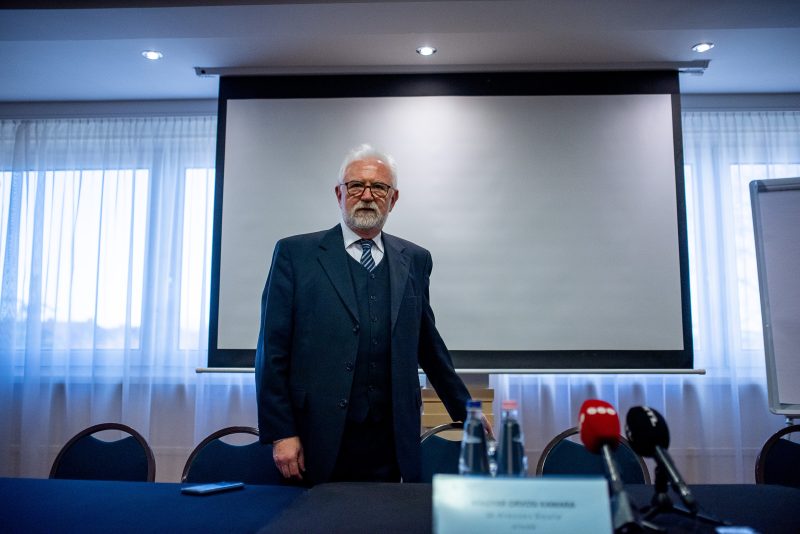- Introduction of the service relationship in healthcare,
- nationalisation of the midwifery system,
- as well as the privately operated MR and CT scanning devices in public services,
- overhaul of the general practitioner system,
- significant increase in doctor salaries,
- elimination of gratuities (“hálapénz”) in healthcare.
– these are just a few fundamental changes that have taken place in healthcare over the past three years. Seemingly, the Hungarian government had made the decisions affecting the operation of the healthcare system in a hasty, haphazard manner, but in reality, the cabinet has a guideline:
a study which is classified for ten years.
This study was also the subject of the lawsuit initiated by K-Monitor, which aimed to obtain the document from the Ministry of Interior via citing public interest. Although the request was rejected by the court , the organisation also endeavouring for transparency in the use of public funds, did not leave the courtroom empty-handed: K-Monitor managed to acquire the contract between the author of the study and the ministry. Moreover, the court ruling provides valuable insights into the background of the healthcare transformation.
To understand the importance of the lawsuit, three dates are worth remembering:
May 2020: Two months after the arrival of the coronavirus pandemic in Hungary. Reports from China and Northern Italy already warn of the dangers the virus poses to people and the brutal strain the pandemic can impose on national healthcare systems. The Hungarian government takes two, seemingly contradictory steps: introducing drastic measures to slow the spread of the virus while deciding to embark on a simultaneous, comprehensive transformation of the healthcare system.
October 3, 2020: The leadership of the Hungarian Medical Chamber visits Prime Minister Viktor Orbán at the Carmelite Monastery, the seat of the Prime Minister’s Office. President Gyula Kincses – who has resigned just recently – along with the two vice-presidents, the also since-resigned Rita Lénárd, and Péter Álmos, participate in what appears to be a cheerful meeting, and photos from the event would flood media outlets. Two monumentally significant, long-delayed decisions are announced: a significant increase in doctors’ salaries and the removal of gratuities (“hálapénz”) from the system.
October 5, 2020: Two days after the historically significant meeting, a law proposal introducing the service relationship in healthcare strikes the medical community like lightning from clear skies. The law, eventually passed in 2021, would unite doctors and nurses – who had previously worked under different legal statuses – into a shared legal category regarding employment, and fundamentally reshape the healthcare system. Many interpreted this as the cost of the increase in doctors’ salaries.
Behind the three seemingly unrelated events lies a study, intended for internal use, authored by the Boston Consulting Group (BCG). The Ministry of Interior commissioned the international consulting firm in May 2020 to prepare a comprehensive study on the state of Hungarian healthcare and make recommendations for its transformation.
To prevent unnecessary interferences influencing lawmakers
Just recently, the Metropolitan Court of Budapest would host K-Monitor’s legal case attempting to obtain the aforementioned study, long rumoured to be the transformation’s guideline, from the Ministry of Interior based on a public information request. The court rejected the plaintiff’s (K-Monitor’s) lawsuit on October 31. Therefore, the classified study is not yet accessible to the public, although the organization plans to appeal the ruling, arguing that decisions of this magnitude should only be made with the involvement of society.
Despite the court ruling, numerous pieces of information surfaced during the trial that support the long-suspected fact that the BCG study from 2020 indeed served – and still serves – as the guideline for important decisions in the on-going transformation of the country’s healthcare system. The court itself emphasized the relevance of the document in its justification for the decision.
The contract forming the basis for the extensive and transformative changes in Hungary’s healthcare sector, along with the resulting study, is sure to garner significant public attention,
the court writes, adding that
making the study and the contract accessible to the public could provide a basis for drawing superficial conclusions.
As, according to the court, there is a risk that lawmakers could be exposed to “unnecessary interference” if the document becomes public. To be exact, the court’s reasoning states:
The positive or negative criticism regarding the work of public officials creating the normative regulation underlying the changes could expose those working in any segment of the transformation to unnecessary interference, potentially hindering or thwarting the transformation process executed in accordance with the study, impeding the effective implementation of decisions, and in the most extreme case rendering public officials unable to work in a manner that is independent, efficient, and free of unauthorised influence
But what can be said about this study that Sándor Pintér (Minister of Interior) and his colleagues are so keen on protecting from public scrutiny? The Boston Consulting Group (BCG), an international consulting firm, has been involved in healthcare reforms in several countries. In 2018, they assisted in the healthcare reform in Slovakia and worked on healthcare systems in Denmark, Iceland, the Netherlands, Sweden, and Germany. The methodology is consistent: BCG conducts a comprehensive, data-supported analysis of the healthcare system in a given country and then proposes specific steps for reform. While these suggestions are not binding for governments, it seems that legislators often use the study as a guiding document. For example, in 2019, the Slovak government would not make it a secret that a study prepared by BCG was one of the facilitating factors in their reform of Slovakia’s hospital system and the development of a long-term concept for the nation’s healthcare.
In 2020, the Hungarian Ministry of Interior signed a contract with BCG for
The consulting company would present the document featuring multitudes of proposals for the healthcare transformation within the same year. It is unclear how many have read or have access to this study. The Hungarian Medical Chamber had previously stated that they did not receive it, a fact confirmed by Gyula Kincses, then-President of the Hungarian Medical Chamber, who was summoned as a witness during the trial.

The trial was also unique in that besides Kincses, Zoltán Jenei, director general of the National Directorate General of Hospitals, would also testify, but the judge approved the request of the Ministry of Interior’s lawyer, stating that Zoltán Jenei could discuss classified data in court, but only in the absence of the public. Nevertheless, the court’s reasoning for their eventual decision discusses several statements made by Jenei during his nearly one-hour long testimony:
- Zoltán Jenei, director general of the National Directorate General of Hospitals, is familiar with the contents of the study.
- Based on the content examination of the contract and the study, the court determined that “the strategy appearing in the title of the contract and the study as a proposal package for the complete transformation of the entire healthcare sector, represents the transformation of its current model in all its segments as well as the comprehensive methodology of this transformation, thus fundamentally defining the future utilisation of available resources and the transformation of the manner of such utilisation. This comprehensive strategy is multi-phased and complex, and not only indivisible into parallel, individual procedures but also includes interrelated, interdependent elements in connection with the transformation of the healthcare sector. Zoltán Jenei’s testimony also supported these facts.”
- The court believes that it cannot be ruled out that the defendant (the Ministry of Interior) might reach certain decisions with principles formulated in the study, wholly or partially corresponding to decisions already made.
- “The entirety of these goals and principles, methods, and proposals is contained by the study hereby requested to be made public, which forms the basis for the continuous execution of central management tasks in accordance with the contents of government proposals studied for the project.”
- The court also determined that “the study forms a coherent whole, from which no part that had served as the basis for already implemented legislation can be singled out. Therefore, it was not significant that, contrary to the plaintiff’s claim, one or more of the laws listed by the defendant as examples had already come into force and had been published in the Hungarian Gazette.”
- “The testimony of the director general also confirmed the fact – already concluded based on the evidence also attached by the court – that certain parts of the study are inseparable and cannot be treated as a part that the defendant would no longer need for decision-making due to that the respective decisions based on them had already been made.”
Zoltán Jenei testified that there are currently on-going decision-making processes, with those involved continuously considering the findings of the study in their work, and there are various projects being prepared based on the study. These include the transformation of the general practitioner system, the transformation of practice communities, the takeover of the school nurse program, and the restructuring of decision-making powers in patient guidance. Numerous necessary and planned measures are also expected in the future, such as the second phase of the salary structure’s transformation and the digital development of healthcare. - The court also noted, based on Zoltán Jenei’s testimony, that some decisions have already been made and implemented, such as the law on the legal status of healthcare workers.
- Meanwhile, some areas still have decision-making processes in progress, whereas there are others where the respective decisions have been made but implementation is still pending.

Why did the government decide to reform healthcare right in the midst of a global pandemic?
Beyond the reasoning provided in the court decision, the contract concluded between BCG and the Ministry of Interior also contains substantial information. According to the contract sent to our newspaper, the Ministry of Interior entered into an agreement with BCG on May 12, 2020, and by August, the study was completed, including a proposal package for the comprehensive transformation of the entire healthcare sector. The date is noteworthy because, at the time of signing the contract, Covid-19 had already appeared in Hungary. By this time, the government had declared a state of emergency due to the pandemic and made numerous healthcare decisions that fundamentally affected the nature of medical care: healthcare workers aged 65 and over were relieved of direct healthcare tasks, and general practitioners’ offices were practically closed as GPs could be contacted by phone for non-urgent health issues.
At this point in time, the gravity of the pandemic already raging in China and Northern Italy could not yet be accurately predicted in the case of Hungary. In any case, the government deemed the time to be suitable for putting comprehensive healthcare reforms on the agenda, and contract BCG for the development of a working document for the project.
BCG explained the reasons behind the timing in its offer addressed to Sándor Pintér, dated April, which is attached to the contract. Essentially, they state the situation created by the pandemic to actually be an opportunity for healthcare transformation. Specifically, they write as follows:
The international and domestic economic, social, and healthcare situation arising from Covid-19 (coronavirus) only intensifies the substantial problems of Hungarian healthcare, bringing fundamental contradictions to the fore and potentially accelerating processes that are already negative and unsustainable. Therefore, it could be worthwhile to capitalise on the situation created by the current healthcare crisis, and utilise it for the reconsideration of the healthcare system.
Although the allegedly thousand-page long, classified working document’s content is not public, BCG’s offer reveals that they meticulously scrutinized the situation of Hungarian healthcare:
Hungary’s healthcare system has been amassing a complex plethora of problems for years, which, upon reaching a critical mass, could jeopardise the sustainable operation of the entire sector and serves as a breeding ground for social dissatisfaction.
Among other things, BCG developed indicators through which the quality of individual institutions and doctors will be measurable in the future. “By promoting conscious quality management, we propose suggestions for regular performance measurement comparisons,” they add.
They also took a hard stance regarding the separation of private and publicly financed care, setting clear boundaries between the two.
As a result, the continuation of private healthcare activities in publicly financed institutions and with publicly funded equipment can be avoided,
they write.
It also becomes clear that the classified working document contains statistics and data on healthcare that may not have been available to anyone until now. The authors of the study stated that they would assess the totality of the country’s medical personnel
from various perspectives: by specialty-specific headcount, demographic data, skills, etc. Additionally, we will analyse relevant labour market trends, such as career choices, emigration, career changes, etc. Using these, we will create a picture of the state and evolution of the healthcare system’s supply of workforce. On the other hand, we will also examine general demographic trends (e.g., aging population, susceptibility to diseases) to understand the changes in demand for healthcare services. Finally, by combining these two factors, we would model the expected labour shortage broken down by specific medical areas.
It was decided within three months: a new era is coming in healthcare
The publicly invisible nature of the country’s decision-making apparatus becomes particularly apparent concerning the mentioned issue of service relationship in healthcare. As discussed at the beginning of the article, the proposal for this law was published on October 5, 2020; just two days after the leadership of the Hungarian Medical Chamber (MOK) had visited Viktor Orbán. On October 3, there was no mention of unifying the employment relationship for healthcare workers in addition to wage increases and abolishing gratuities. Numerous doctors of MOK reported of the Chamber not being informed at all prior to the decision. They emphasized that their main issue was not necessarily the introduction of the new employment relationship (although the proposed issues of reassignment and qualification met colossal resistance, but rather, they expressed resentment that the government had made this weighty decision on its own, bypassing the profession entirely.
Based on the court decision at the end of October, a likely timeline of the decision-making process can be established: the Boston Consulting Group’s study, including the “idea” of the service relationship, was on Sándor Pintér’s desk already by August, and in October, during the meeting at the Carmelite, Viktor Orbán knew already exactly what neither MOK nor anyone else could know: a new era is coming in healthcare.

The Slovak Patient
Regarding why it is necessary to classify a study serving as the basis for the entire healthcare system’s transformation for years, BCG project manager Ákos Újlaki has weighed in on the issue several times in various interviews. The last of these instances, for example, was in March this year, shortly after mandatory membership in the Medical Chamber had been abolished. Then, he would claim
The Central and Eastern European project manager and healthcare expert of the Boston Consulting Group also participated in the preparation of the Slovak healthcare reform. Slovakia faced familiar problems: too many hospitals, too few doctors, expensive and poor-quality care.
We contacted the Slovak Ministry of Health to inquire whether the 2018 Slovak study is public or not; we have received no answer so far. It seems certain, however, that although Bratislava did not exactly strive to have the public know everything about the healthcare reforms’ preliminary study, they did not treat it as completely confidential, either. They continuously communicated the main elements of the transformation to the public. A Slovak government official told K-Monitor that key charts and data from the study were also made public.
The central element of the Slovak healthcare transformation is the hospital reform, at the heart of which lies the categorisation of institutions. Hospitals were divided into five different categories depending on the risk level of surgeries performed at each facility. In the first, so-called community-level hospitals, only basic care would be available from 2024, while hospitals on the last, fifth level would take care of the most complex surgeries that other hospitals cannot handle.




